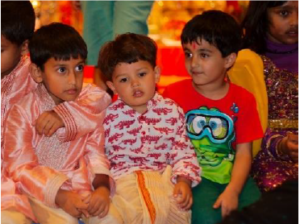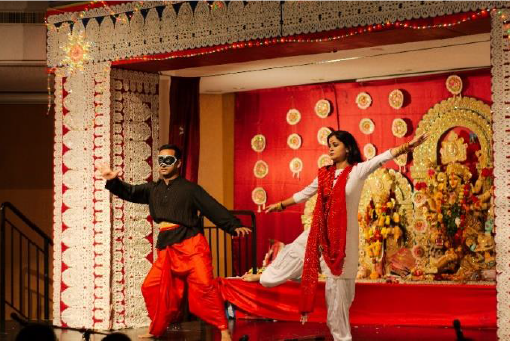A Durga Puja that’s Bong in spirit, German in feel: that’s what the annual Puja in Frankfurt, Germany, organised by a Bengali Association consisting of 150-odd members, looks like.
Although Frankfurt is reputed to be more multicultural than most German cities, you don’t quite get the desi feel of San Jose in the Silicon Valley or the London hub of Southall though.
That’s partly because many Indian immigrants here aren’t living in what desis themselves in the States archly call the ghetto. And a fair number of Bengalis here have German spouses or partners — or a parent, for that matter. Still, at the rehearsals for the Puja cultural programmes, which begin about a month before the Pujas, inevitably the lingua franca turns out to be English rather than Bangla. No surprises there.
The callisthenics of German grammar may have reminded many Indians of tales of horror from having learnt Sanskrit, for anyone brave enough to have tried. Many of the kids though revel in their guttural Teutonic “r”s and “ch”s, which pepper their grammatically flawless Bangla. Small wonder then, that goosebumps of alarming nostalgia can be triggered off by a sudden tune-in to the whiny notes of a harmonium, or the shockingly familiar sight of gnarly tabla skin being scrubbed with talcum powder.
I’m training my toddler son, not yet three years old, into the ethos of manic productivity. Into Korrektheit (correctness). Praezision (precision). Close cousins in meaning to the English words they look like. Like every socks-and-sandals clad German tourist, who has read up every guidebook on the planet so there are no nasty surprises waiting, I’ve entertained my son with Youtube clips of Durga Puja, just so he knows what he’s (not) missing out on. It’s important that children learn to be curious.
Please don’t forget they’re watching! All the bhog-toting ladies and gentlemen from the local Indian Consulate, for example, keen to spot a winning candidate for the annual celebration of the “Frankfurt Intercultural Weeks” next year. Equally hawk-eyed are the corporate moguls, whose sweet talk wangled the stash that made the annual Puja magazine possible, in which everyone like myself discovered that they hadn’t abandoned poetry or painting in the first year of college. There is no such thing here as chalta hai. Every production is, or at least must be, uncompromising.
Did I just say that the cultural programmes performed at our Puja here in Frankfurt must be put together with a generous dollop of professionalism, because you never know who’s watching you. In this piece, I’m going to completely unsay that. Because now, midway through the Awfully Big Adventure, it seems clear that the programme performances every evening have more of the feel of a typical paara’r function, where everybody knows each other and you daren’t smirk at the fat Rabindra Nritya dancer on stage, because you don’t know whose mum or wife or daughter she might be. So it’s not like nobody’s watching. Everybody’s watching, because they’re just glad to have somebody to watch.
In the movie Abohoman, director Rituparno Ghosh brings in one of his dialogues about how delusional it is to think that one can actually capture a moment in time on celluloid. Indeed, the idea kept haunting me as I scribbled out a script for our ambitious cultural programme — a tribute to Ghosh, film star Suchitra Sen and singer Manna Dey. There was no recapturing that magic moment when the unassuming, sweaty Shikha Sarkar in Abohoman morphs into a pouting celluloid goddess, mouthing the laments of Radha we all know too well from Bhanusingher Padaboli and Hindustani classical vocals.
As I bricked up the script from film reviews on the net, Wikipedia content, and Youtube clips, in the blink of an eye, one could see Bhanusingher Padaboli in the form of Tagore’s original Bhanusingh Thakurer Padaboli, that immortal act of literary forgery committed by a sixteen-year old genius in Brajabuli. That was a language whose modern cousin, Maithili, would have a strangely familiar vibe to many of the Puja participants here, hailing as they do from the borders of Bihar and West Bengal.
The more I swivelled into rounds of new acquaintances, the clearer it was that there weren’t just textbook Calcuttan Bengalis running the show, but also a large pan-Indian population from the eastern industrial belt touching West Bengal, Bihar and Odisha. Having spent my younger years in the steel towns of Durgapur and Jamshedpur, I could tune into the nostalgia of people from Bokaro or Rourkela for sugar-coated macha sandesh from Purulia and Bankura, saffron-tinged chanar pulao from Bardhaman or creamy peda from Deoghar. Not for us the Calcuttan rossogolla, Bhim Nag sandesh or mishti doi.
I suspect that the presence of the Steel Authority of India Limited or its offshoot industries was not a coincidence, because from what I remembered of the ’90s, the two career options that young people were supposed to opt for in these areas used to be engineering and medicine. If Indian IT professionals, all the way through Nestlé to Tata Consultancy, are in demand in the German market today, the aspirational—if blinkered—culture of those times and places may well have played a role.
The duct tape on the Puja dhak seems to be holding up well, from the day of Ashtami onwards the rhythms have been getting more and more manic, there’s just so long you can stay in the otherwise nondescript main hall where the Puja is taking place. The crowds are surging in, not just from Frankfurt—with the addition of Navratri celebrants—but also from the nearby cities and towns of Heidelberg, Mannheim, Mainz, Kaiserslautern, Giessen, even Stuttgart.
To be honest, seeing the slew of cultural programmes, I’m not sure that I’m at a Bangali pujo any more with the usual staple of aabritti, where a well-dressed performer keeps reciting soulful lines of poetry, raising ohs and ahs from some, and secret sniggers from many. But more often than not, what really holds the audience is what our parents— grandparents? – would’ve brushed off as “Hindi cinema’r gaan,” indeed, “apasanskriti” or “degenerate culture,” the bête noire of the former Left Front state government. Here on stage is a dance to the folksy lilts of “Nagada sang dhol baaje.” This must be the nth song on the planet featuring the phrase “dhol baaje.” The audience is hooting, mesmerised at the acid brilliance of a tall young woman in a swirl of skirts. She’s a veritable cyclone of mauve and silver, and my son, scared to death, runs to the comforting shade of Papa-Mama.

Boli! boli! Shouts someone. I rush over, pretty sure there wasn’t an Alpine billy goat being led officiously to the stake. Instead there’s a pumpkin, brightly painted with a sindoor swastika that cannot—will not—be confused with the embarrassing symbol of Nazi times. The gathered crowd has stilled its breath as the principal actors with gamcha bandannas hold their chopping knives aloft. The knives slice the air, and I’m not the only onlooker happy to miss heart-wrenching bleats and a fountain spray of crimson.
On the day of Dashami, the Pujaris come in, armed with bronze plates boasting kalakand, pantua and laddoos from the Bangladeshi, Punjabi and Afghani shops at the nearby red-light district, the Bahnhofsviertel. Other plates are piled with local Raffaello chocolates with a grated coconut topping, and crunchy Ferrero Rocher balls with the familiar gilt wrapping.
In an hour we’ll be downing the sweets and chocolates as glucose shots inside the green room, as we pin up sarees or slip into anarkali suits for our cultural programme.
Endlich, as the locals would say. But for the moment, the Pujas are officially over and there’s a feel of release in the air. What do you do with people of the opposite sex one isn’t pally enough for a kolakuli with? Namashkar to a person you say the informal “tumi” to, doesn’t quite work. Well, I see that our generation has found a decent solution in a handshake that accompanies the greeting of “Shubho Bijoya.” It’s a bit like the overjoyed “Peace be with you” after a Mass at church. But I like it, it says that times have moved on.
Everyone—men, women, children—has at least a forehead streaked with vermilion now. In the green room, all I have to do is wash off the extra bits and apply blusher to even out the shades before I walk out on stage.
“Shubho Bijoya, meine Damen und Herren/ ladies and gentlemen.”
[Photographs: Matthias Rosenkranz]


Comments are closed.